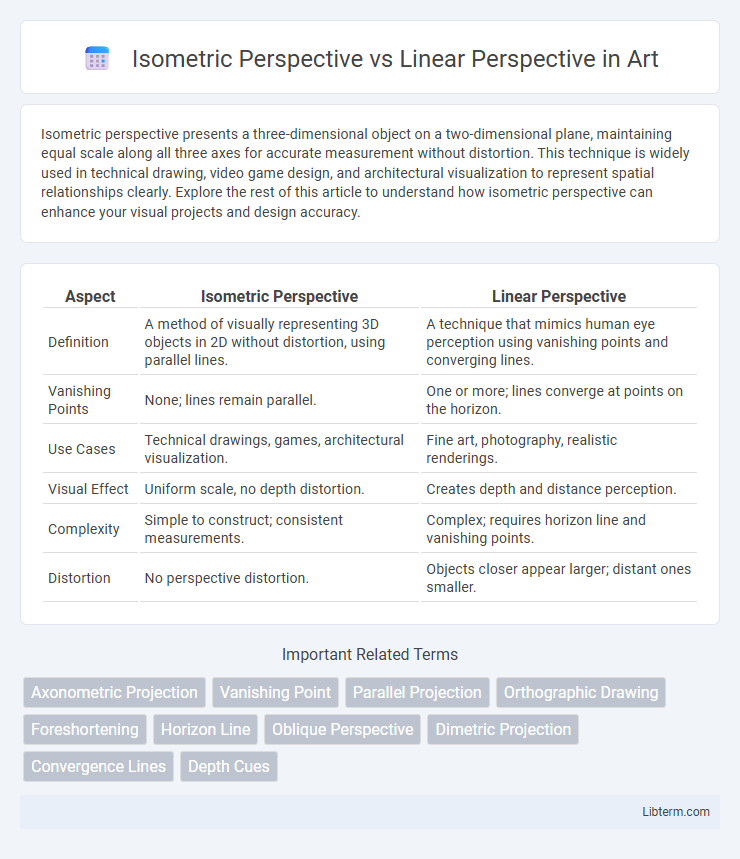Isometric perspective presents a three-dimensional object on a two-dimensional plane, maintaining equal scale along all three axes for accurate measurement without distortion. This technique is widely used in technical drawing, video game design, and architectural visualization to represent spatial relationships clearly. Explore the rest of this article to understand how isometric perspective can enhance your visual projects and design accuracy.
Table of Comparison
| Aspect | Isometric Perspective | Linear Perspective |
|---|---|---|
| Definition | A method of visually representing 3D objects in 2D without distortion, using parallel lines. | A technique that mimics human eye perception using vanishing points and converging lines. |
| Vanishing Points | None; lines remain parallel. | One or more; lines converge at points on the horizon. |
| Use Cases | Technical drawings, games, architectural visualization. | Fine art, photography, realistic renderings. |
| Visual Effect | Uniform scale, no depth distortion. | Creates depth and distance perception. |
| Complexity | Simple to construct; consistent measurements. | Complex; requires horizon line and vanishing points. |
| Distortion | No perspective distortion. | Objects closer appear larger; distant ones smaller. |
Introduction to Isometric and Linear Perspectives
Isometric perspective presents three-dimensional objects without distortion, using parallel lines and equal angles of 120 degrees, which maintains scale and proportion regardless of depth. Linear perspective mimics human vision by converging parallel lines toward vanishing points, creating depth and realism on a two-dimensional plane. Understanding these fundamental views is essential for architects, game designers, and illustrators aiming to convey spatial relationships effectively.
Defining Isometric Perspective
Isometric perspective is a method of visually representing three-dimensional objects in two dimensions, where the three axes are equally foreshortened and the angle between any two axes is 120 degrees. Unlike linear perspective, isometric projection maintains scale regardless of object depth, eliminating vanishing points and distortion. This technique is widely used in technical and engineering drawings, as well as in video game design, for its ability to clearly display spatial relationships without perspective distortion.
Understanding Linear Perspective
Linear perspective is a technique in drawing and painting that creates the illusion of depth by converging parallel lines toward one or more vanishing points on the horizon. This method mimics how the human eye perceives space, making objects appear smaller as they recede into the distance. Understanding linear perspective is crucial for achieving realistic spatial relationships and accurate proportions in artwork and architectural designs.
Key Visual Differences
Isometric perspective depicts objects with parallel lines that never converge, maintaining equal scale regardless of depth, which preserves proportions and allows clear visualization of technical details. Linear perspective uses vanishing points where parallel lines converge, creating a realistic sense of depth and distance but distorting object shapes as they recede. Key visual differences lie in isometric's uniform scale and non-converging lines versus linear's depth cues through converging lines and diminishing sizes.
Technical Principles Behind Each Perspective
Isometric perspective relies on parallel projection where all axes are equally foreshortened at 120-degree angles, preserving scale without vanishing points, making it ideal for technical illustrations and video game graphics. Linear perspective uses converging lines toward one or more vanishing points on the horizon to simulate depth and spatial relationships, closely mimicking human visual perception in realistic scenes. The technical principle behind isometric projection ensures uniform measurement along axes, while linear perspective employs mathematical rules of convergence to depict three-dimensional space on a two-dimensional plane.
Applications in Art and Design
Isometric perspective, often used in video game design, technical illustration, and architectural drawings, enables a three-dimensional representation without distortion, allowing for consistent scale and measurement across axes. Linear perspective is favored in fine art, photography, and realistic rendering, creating depth by converging parallel lines toward vanishing points, simulating human eye perception. Artists and designers select isometric perspective for clear spatial relationships and linear perspective for dynamic depth and realism in their compositions.
Advantages of Isometric Perspective
Isometric perspective offers the advantage of maintaining consistent scale and proportions without distortion, making it ideal for technical drawings and video game design where accuracy and clarity are crucial. Unlike linear perspective, it does not rely on vanishing points, which simplifies the visualization of complex objects from multiple angles simultaneously. This approach enhances spatial understanding by providing clear, measurable dimensions, aiding designers and engineers in precise planning and communication.
Strengths of Linear Perspective
Linear perspective excels in creating realistic depth and spatial relationships by converging parallel lines at vanishing points, mimicking human visual perception. This method enhances the three-dimensional illusion in artworks, architectural plans, and visual media, making objects appear proportionally smaller as they recede into the distance. Its strength lies in providing an accurate representation of real-world scenes, enabling precise scale and distance measurements.
Choosing the Right Perspective for Your Project
Choosing the right perspective for your project depends on the desired visual effect and functionality. Isometric perspective maintains equal scale along parallel lines, enabling clear representation of 3D objects without distortion, ideal for technical drawings and video game design. Linear perspective introduces vanishing points to mimic realistic depth and spatial relationships, making it suitable for architectural renderings and visual storytelling.
Conclusion: Comparing Isometric and Linear Perspectives
Isometric perspective maintains scale without convergence, preserving dimensions for technical and game design clarity, while linear perspective mimics human vision through vanishing points, enhancing depth and realism in art and architecture. Choosing between isometric and linear perspectives depends on the need for accurate proportional representation versus immersive spatial experience. Effective application of these techniques impacts visual communication by balancing precision with perceptual depth.
Isometric Perspective Infographic

 libterm.com
libterm.com